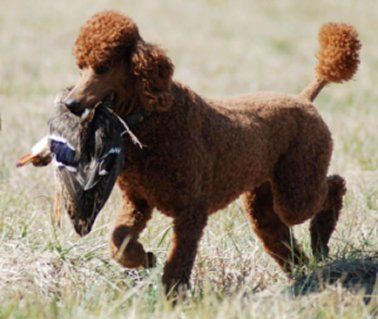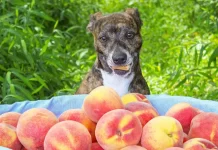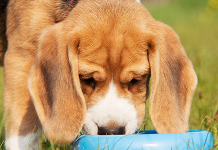Standard Poodle Hunting Cut
Most people cannot imagine sitting with a poodle in a duck blind or running the fields for pheasant and shooting over a Poodle. Their first thoughts of a Poodle are the little white dogs with terrible haircuts.
- Brown Sable Poodle Color Change
- Blue Merle Poodle Puppies
- Standard Poodle Hunting Cut
- Toy Poodle Allergies
- Can you be Allergic to a Poodle?
- Are Toy Poodles Hypoallergenic Dogs?
- Black Bichon Poodle Mix: Poochon Dog Breed Complete Guide
- Siberian Husky Poodle Mix: mini Huskydoodle Puppy
- German Shepherd Poodle Mix – Mini Shepadoodle Puppy

Even the American Kennel Club classifies the Poodle in the “Non-Sporting Group”. The standard poodle, however, is one of the most underrated dog breeds for both upland and waterfowl hunting.
If you’ve never seen a Poodle in the field, you may be surprised to see a dog with an impressive intellect, drive, and intensity in the field.
Why Standard Poodles Make Great Hunting Dogs
Standard Poodles are different. Many centuries ago, Poodles began their journey as retrieving water dogs in Germany. It’s actually where they got their names. The word “pudeling” actually means “splashing in water” in German.
Shortly after, Poodles eventually became immensely popular among the nobles of France as well as other parts of Europe. And finally, the Poodle made its way to England after years of exhibiting highly capable retrieving abilities.

So while Standard Poodles may not be what you imagine as a hunting dog, they certainly are. It’s just that Poodles serve a different purpose than the Beagle (tracking) or the Ridgebacks (attack game). That said, here’s what made them top retrievers.
Poodle coat for the water
- Hunting instincts, prey-drive and work ethic are not the only qualities that make Poodles good hunting dogs. In fact, the Poodle’s coat is unique. Not only is it hypoallergenic (rarely sheds), but also provides the dog with protection against water.
- When retrieving, Poodles needed to swim through cold marshlands, swamps and lakes to bring back the shot waterfowl. They mostly retrieve ducks, geese and other aquatic animals. Since a Poodle spends much time in water, they needed a waterproof coat.
- Ever wonder why Poodles have pom pom cuts? It’s not all for show. Rather, these extra balls of fluff are placed in areas of the Poodle’s vital organs. As such, this provides better insulation when swimming in freezing cold water.
- In addition, the Poodle’s coat will be dense, yet curly. But because they’ll have a single coat, the Poodle won’t be weighed down with a soggy fur coat. They’re able to retrieve in water with more ease, thus making them efficient at retrieving.
- As for the origins of the Poodle’s unique hairdo? It has to do with the style that was favored by French “nobility” of the 18th century, under Louis XVI. It’s both stylish and functional, which is probably why these cuts are still around today.
Easy to train Poodles to hunt
- Poodles are highly intelligent dogs. And when it comes to obedience and training, they’re even better than the rest. According to Stanley Coren, a pHD and canine psychologist, Poodles are the 2nd smartest dog for work & obedience IQ.
- Out of 138 dog breeds, only the Border Collie scored better than the Poodle. This meant that a Poodle is capable of learning a new command with fewer than 5 repetitions. Plus, Poodles will obey a known command with a 95%-plus success rate!
- With such high intelligence and obedience, it’s easier to mold these fluffy dogs into the perfect hunting companion. And as a result, they pretty much were. Many of them work for the sake of working, which reduced challenges for hunters
Poodles are active hunters
- Despite popular belief, Poodles are active dogs. These dogs were bred to be this way, which is also why they were standout hunting companions. And according to the AKC, Poodles are one of the 15 most active dog breeds!
- Needless to say, active dogs make the best hunters. In fact, activeness is a quality even more important with water retrievers. Swimming can be tiring, especially because they had to swim through marshes where waterfowl hunters often hunted.
- Poodles tend to be very playful, bouncy, and fun. They are water retrievers and are very smart and trainable, however some seem to be hyperactive or neurotic.
- The marshlands is essentially a wetland dominated by wild grasses, rushes and or reeds. All of which, can be big obstacles while swimming. It’s why active dogs, such as Poodles, are often the best suited for these swamp-like conditions.
- Sending in a laid-back or low energy dog breed, such as a Great Pyrenees, may not end well for the dog. And while all individual dogs may be different, most Poodles know when to turn on their energy-levels like a switch of a button.
Modern Hunting Poodles
- While many Poodles dominated in Europe during the hunting glory days, this may not be the case anymore. Even so, the Standard Poodles have somewhat returned in recent decades to their hunting roots with some breeders.
- As a matter of fact, some establishments in the USA and Canada are now specifically breeding these dogs to be hunting companions and retrievers, once again. This meant a bigger focus on a hunting dog’s temperament, as opposed to a companion dog’s.
- Once dog owners get into a serious hunting relationship with their Poodle, they attest that their Poodles are second-to-none when it comes to hunting and retrieving. Considering the variety of excellent water retrievers, that’s a bold statement.
Poodle Temperament
- Poodles had the temperament of a true hunter. For example, Poodles are some of the smartest dog breeds around. In fact, they’re right up there with the Golden Retriever and the Labrador Retriever – who are also excellent water retrievers.
- But thanks to the intelligence, Poodles excel at more than just hunting. They tend to do well in several dog sports, such as dog agility, fly ball, dock diving, disc dog and dog surfing. They’re always winning shows, events and competitions!
- On the other hand, there is a misconception that Poodles are pampered sissies. But the truth is, they possess the instincts and temperament of top retriever gun dogs. You’ll find very few dogs as active, outgoing and hard-working as a Poodle.
- The standard poodle is the best dog. They are protective and loyal. They’ll walk for hours with you or keep you company, or lay in bed all day if you are sick.
- In addition, they’re quite loyal and tend to easily bond with the family members. However, they can be a bit shy around strangers. This also makes them good watch dogs, as it’ll take them some time to warm up to unfamiliar people.
- Faith in the owner is large why Poodles are so responsive on their hunting trips. The loyalty will keep them always wanting to please by performing their “jobs” to the highest abilities.
- Plus, Poodles will protect their owners or at least attempt to. Don’t believe me? Just check out the story this article illustrates. For the most part, Standards are shyer than Mini and Toy dogs. Surprisingly, Mini Poodles are the most active of the three.
Physical Attributes of the Hunting Poodle
Hunting Poodle Origins
- Technically, any poodle that stands more than 15 inches at the withers is a standard poodle. However, most hunting poodles stand much taller, with males 24 to 26 inches and females 22 to 24 inches. Such males weigh 45 to 60 pounds; such females weigh 40 to 50 pounds.
- These dogs are tall and lithe rather than short and stocky. Being lean and muscular, they have boundless energy and great stamina. Being highly athletic (whence comes their trick-dog image), they move with attractive grace and style.
- Now for the typical hunter’s No. 1 FAQ (frequently asked question): What about that mass of curly hair called the poodle coat?
- The coat may be any of several solid colors, most commonly black, gray, brown, apricot and white. Notably, this coat doesn’t shed. That makes it every homemaker’s favorite among canine coats. No dog hairs on the rug, sofa, bed or wherever. Then, too, this coat is hypoallergenic, which makes it the choice of dog lovers who are allergic to breeds that shed.
- Since it doesn’t shed, if left untrimmed the coat will grow continuously. When it gets long enough, the fur braids itself into long cords that drag on the floor. Thus, every poodle must be trimmed regularly, which is a time-consuming job, even for a professional groomer, and an expensive job for amateurs who choose not to trim their own poodles.
- But–and for hunters this is a most important but–no law, rule or directive requires a hunter to keep his poodle in those outlandish dog show trims that make the dog look like a sissified male lion. Au contraire, the hunter may, can and should keep his poodle’s coat trimmed down to somewhere around one inch long all over. At that length it curls tightly up against the skin.
- Although trimming a poodle this way takes time and effort, it requires neither tonsorial skill nor artistic talent. Of course, it must be done frequently, say once a month. “During hunting season, the coat should be an inch long, or maybe a bit longer,” said Angie Louter.
- Thusly trimmed, the coat protects the dog in all but bone-chilling water. It will also protect him from upland briars and brambles. It does pick up burrs, but the boss can easily pluck them out with a dog comb or rake. To help slide them out easily, some hunters first spray a little cooking oil on each burr.
How to Train Poodles to Hunt
Training Poodles to hunt is similar to training Poodles in general. These highly intelligent dogs don’t require too many repetitions of commands to learn.
In addition, to ensure the Poodles don’t get bored by their training regimen, you’d need to mix things up and keep the training interesting. If you are planning on taking your dog on hunting trips, they need to be acclimatized to wooded areas.
Start Early & Teach the Basics
- It’s always good to start training your dog early, no matter what breed and no matter to what end. Though Poodles are much easier to train, the longer you postpone their training, the more difficult it becomes.
- With Poodles, you can get them started on learning basic obedience commands such as sit, stay, down, come and fetch. This is essential because it gives you better control of your dog in the open field. Plus, it develops trust between you and the Poodle.
- Dogs are great at learning from other dogs. Poodles are no exception. You can take your young Poodle puppy on hunting trips where the newbie stays leashed and just observe other, more experienced dogs at work.
- You’ll also want to “introduce” the dog to the animal they will be retrieving. Start by introducing your Poodle to a tame, pen-raised bird, such as a quail or a pheasant. They need to learn to not be scared of birds to be able to retrieve them.
- Next, you’ll want to teach your Poodle the freeze command. For example, if you say the word “whoa,” your Poodle should immediately stop in its tracks and look towards you. They need to learn this well since hunting requires patience.
- Finally, teach your Poodle to look for a tame bird in a contained outdoor area. Keep the dog on a long leash while you’re training so as not to harm the bird (or potentially the dog). Slowly, continue with this training while the dog is off-leash.
Advanced Poodle Hunting Tips
- Play fetch with your Poodle using a tennis ball to ensure that the dog learns to release the object (ball or bird) on command. Make sure that you always reward your dog with a treat and positive praises for retrieving the tennis ball.
- Your Poodle needs to learn this command exceptionally well, as it is a crucial command during actual hunting. Once you feel your Poodle is ready for an actual hunting trip, you can take him or her out with other dogs to acclimatize to the sights and sounds of hunting.
- It’s better for the dog to get used to the sights and sounds that are associated with hunting. Not only do these sounds include animal noises, but also the sound of gunfire, running water and especially the game that they’re going to “hunt.”
- Move on to bird dummies instead of tennis balls to continue your Poodle’s retrieval training. You can plant the dummy at various distances or throw the dummy into the air, and ask your dog to retrieve it.
Blind Retrieval Training
- Once your Poodle has perfected and gotten used to dummy retrieving, you can move on to practice blind retrieval training or retrieving bird carcasses.
- Blind retrieval is where your Poodle doesn’t know where the dummy is placed and you direct your Poodle to the dummy with hand signals or verbal commands. The hand signals and commands can be anything you choose.
- And finally, start letting your Poodle loose in actual retrieval situations, preferably with another, more experienced dog present. Along the way, make sure to give helpful directions and always reinforce with praise if your dog succeeds.
- If your Poodle fails at first, let the more experienced dog retrieve. Punishment does not work well with Poodles. Hiring professional trainers is also an option that owners should keep in mind. But it’s best for the dog to be trained by his or her owner.
Frequently Asked Questions
Are Mini & Toy Poodles Hunting Dogs?
- Poodles come in three size variations: Standard, Miniature, and Toy. The Standard Poodle is significantly larger, weighing up to 70 pounds! On the other hand, Toy Poodles can be just 7 pounds and Miniatures range around 20 pounds.
- If you are wondering if there is any variation in temperament between Standard Poodles, Toy Poodles and Miniature Poodles, the answer is “yes.” The reasons for this is fairly obvious.
- While Standard Poodles have been around for more than five centuries, the smaller Toy and Mini varieties are of recent origin and a product of customer demand. In other words, smaller Poodles were bred for the purpose of companionship.
- So while the Standard Poodle has been a superb hunting companion for centuries, the smaller variations were bred specifically to be excellent pets and not much more. And due to their size, Mini and Toy Poodles are not suitable for hunting and retrieving.
- However, some will still retain much of the hunting instincts, in addition to the water-proof coat. These ‘lapdogs’ have acquired traits that most dog owners love. That is, the smaller variations love to snuggle in your lap and love to be patted.
Do Standard Poodles Make Good Hunting Dogs?
What Were Poodles Bred to Hunt?
Are Standard Poodles Hypoallergenic?
Are Standard Poodles Good with Kids?
How Do You Train a Poodle to Hunt?
Do Poodles Point?
Final Thoughts
I think it’s safe to say, Poodles are good hunters. However, they may not automatically make it to a list of greatest hunting dogs. To check out some serious contenders, you may want to check out these versatile pointer dogs instead.
Having said that, some lists do feature Poodles on the list of best hunting dogs, alongside the usual retrievers, hounds, spaniels, pointers, and…the Dachshund (yes, really). And on the bright side, Poodles are very trainable for hunts.
One Poodle owner tells us
The hunting drive is there with my Poodle. I have had to hold him when squirrels, cats or other critters pass nearby. The instincts are high, which is why they’re good hunting dogs.
There are many hunters who will attest to how good their Poodles have been on their hunting trips. However, a hunting Poodle is not as common as you’d think. And for that reason, we do not see them on the field – making them underrated hunting companions.
At the end of the day, Poodles can make great hunting dogs if you put in the time and effort to train them. After all, they were born with these great instincts. These dogs just need the proper experience and training to thrive on the field.






